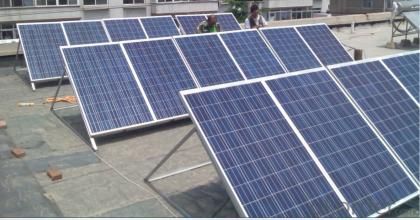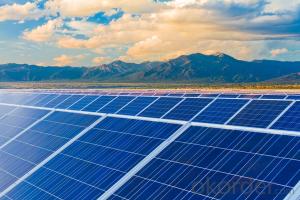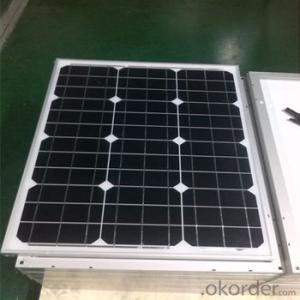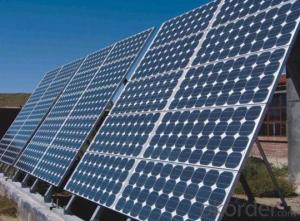(100W) CNBM Solar Polycrystalline 6 Series
- Loading Port:
- Shanghai
- Payment Terms:
- TT OR LC
- Min Order Qty:
- 100000 watt
- Supply Capability:
- 10000000 watt/month
OKorder Service Pledge
OKorder Financial Service
You Might Also Like
About us
CNBM International Corp, established in 2004, is the business entity for trade and logistic of CNBM Group.With the advantages in Cement, Composite Materials, New Building Materials and Engineering, CNBM mainly concentrate on coal, steel and construction equipments and give priority to solar and wind energy development.CNBM International is highly recognized by its business partners and clients all over the world and has established good business relationship with the customers in over 120 countries and regions all over the world.
Solar cell module production process
Line called packaging line components, packaging is the production of solar cells a key step in the packaging process without a good, multi-well battery is also not a good component of production boards. Battery package not only the battery life is guaranteed, but also to enhance the combat strength of the battery. Product quality and high service life is to win can be the key to customer satisfaction, so the quality of components of the package board is very important.

Data sheet
| Characteristics | |
| Max Power Voltage Vmp (V) | 17.6V |
| Max Power Current Imp (A) | 5.69A |
| Open Circuit Voltage Voc (V) | 22.6V |
| Short Circuit Current Isc (A) | 6.09A |
| Max Power Pm (W) | 100W |
| Temperature Coefficient of Cells | |
| NOCT | 47℃±2℃ |
| Temperature Coefficients of Isc (%/℃) | 0.06% |
| Temperature Coefficients of Voc (%/℃) | -0.33% |
| Temperature Coefficients of Pmp (%/℃) | -0.45% |
| Mechanical Data | |
| Type of Cells (mm) | Poly156*104 Poly156*52 |
| Dimension | 1020×670×30mm |
| Weight | 7.7kg |
| NO.of Cells and Connections | 4*9=36 4*18=72 |
| Limits | |
| Operating Temperature | –45°C to +80°C |
| Storage Temperature | –45°C to +80°C |
| Max System Voltage | 700V |
FAQ:
1. How long will my inquiry get response?
Your inquiry related to our products or prices will be replied within 24 hours.
2. Can I get professional service and suggestion?
Well-trained and experienced staffs to answer all your questions in fluent English.
3. Do you accept OEM or customized design?
OEM & ODM, any your customized lightings we can help you to design and put into product.
4. What if I need specific design?
Distributorship are offered for your unique design and some our current models.
- Q:What is the warranty period for solar panels?
- The warranty period for solar panels typically ranges from 10 to 25 years, depending on the manufacturer and the specific product.
- Q:im trying to run my house with with solar panels, is it possible? if so please let me know how....i have a 6000 w inverter
- In my opinion you can do it. You will need to have solar panels. and batteries to store the power until needed.
- Q:Exactly How much power will this kit produce? for example. Will it only be able to power the 2 light throughout an entire day or would it be able to power a couple TV's with a couple lights. Or a Refrigerator? washer dryer? I'm just wondering exactly what it will be able to do and if it's worth paying $200 for if it'll only power two lights. Don't get me wrong, That's great and will make a difference but i'm looking for something that will make a little bit of a bigger difference. Would the 80 watt monocrystalline solar panel be much better? if so, what would it be able to power? double?
- This Site Might Help You. RE: 45 Watt Solar Panel Kit Harbor Freight? Exactly How much power will this kit produce? for example. Will it only be able to power the 2 light throughout an entire day or would it be able to power a couple TV's with a couple lights. Or a Refrigerator? washer dryer? I'm just wondering exactly what it will be able to do and if...
- Q:Can solar panels be used to power a swimming pool?
- Yes, solar panels can be used to power a swimming pool. Solar panels generate electricity from sunlight, which can be used to operate pool pumps, heaters, and other pool equipment. This helps reduce reliance on traditional energy sources and can result in cost savings.
- Q:Can solar panels be installed on theme parks or entertainment venues?
- Yes, solar panels can be installed on theme parks or entertainment venues. In fact, many theme parks and entertainment venues around the world have already embraced solar energy as a sustainable and cost-effective solution. By installing solar panels, these venues can generate their own clean energy, reduce their carbon footprint, and save on energy costs in the long run.
- Q:All I know is they check for amps watts voltage and everything... they dont have to be used for solar panels but um they have like alittle spinny thing in the middle of them. you spin it around to what you wanna test such as the amps watts voltage and stuff.... idk what their called but im looking to buy one to test my solar panels when they come in
- Voltmeter.
- Q:Can solar panels be installed on a carport?
- Yes, solar panels can be installed on a carport. In fact, carports are a great location for solar panel installations as they provide ample space and a suitable structure to mount the panels. Installing solar panels on a carport can help generate clean and renewable energy while providing shade and protection for vehicles parked underneath.
- Q:Can solar panels be installed on factories or manufacturing facilities?
- Yes, solar panels can definitely be installed on factories or manufacturing facilities. In fact, these large industrial buildings often have expansive roof spaces that are ideal for installing solar panels. By harnessing solar energy, factories and manufacturing facilities can significantly reduce their reliance on traditional energy sources, lower their carbon footprint, and potentially save on electricity costs in the long run.
- Q:I have four power packs for solar lights. They have 3 AA .2volt batteries of 2450 mAh capacity installed in series for a total supply voltage of 4 volt maximum for the lights. I want to charge all four packs at once off a single 6 volt solar panel. With the four packs wired in parallel, what capacity output (wattage) panel do I need to charge the batteries in an 8 hour day?
- Each battery pack has the equivalent of only 2450mAh capacity at 4 volts, so for 4 battery packs like that, a total capacity of 9800mAh. Assuming that the solar batteries have no charge left after being on all night, and that day charging time equals night discharging time, the theoretical wattage would be 9800mA times 6 volts = 59 watts. Of course, battery charging is not 00% efficient, so you need more wattage than that. Plus, solar panels are rated at peak output at midday, while at other times of day their output is less than rated. And, the charging in parallel isn't a good idea, because real batteries have different internal resistances, some batteries would become overcharged, while other packs wouldn't get the charge they need.
- Q:a fiber optic network could distribute solar energy from warm states to the rest of the country. Using a Federally created program,the energy would be used through a trust program to benefit all of our citizens equally. It would create thousands of jobs and help us with our dependence on foriegn oil supplies. This is no different than work programs created by the Feds during the 930's depression era.
- This is a great idea, but there are some intrinsic difficulties with the theory: First, the average US household uses 27.4kWh of power per day= aprox. 0,000 kWh per year. Solar panels create kWh/m^2/day. Therefore you would need 27 m^2 (290 ft^2) of solar panels per household. Not only does that use a lot of space, but it would also cost a fortune. We also have to take into account that the government does not want us to become dependent of oil for many reasons. Therefore it is unlikely the government would ever consider paying for it. Lastly, for power grids to stay functional at all times, backup power plants must be kept 'hot', to replace solar power stations as they stop producing. There is an energy cost to keep plants 'hot', which includes (in the case of coal plants) the burning of coal. Unfortunately, if the country is not willing to accept brownouts, the carbon footprint of any large scale solar project will have to accept the 'hot' non-producing power plants carbon emissions as their own. The continued advances in the ability to store electricity will greatly impact the successful implementation of a large scale solar power station being, carbon footprint free. However, it would be possible for every household to have their own solar panels. Since they would need about 290 ft^2 (or 5ft x 5ft), then it does seem reasonable that they could have this much on their roof or land somewhere. Any additional energy you make from the solar panels you can sell back to the power plants and make money. They could then use this extra energy to cover in brown out situations, etc. In order for this to work though, we would all need to be responsible for purchasing and installing our own solar panels. It would be nice if the government would offer greater incentives to do so.
1. Manufacturer Overview |
|
|---|---|
| Location | |
| Year Established | |
| Annual Output Value | |
| Main Markets | |
| Company Certifications | |
2. Manufacturer Certificates |
|
|---|---|
| a) Certification Name | |
| Range | |
| Reference | |
| Validity Period | |
3. Manufacturer Capability |
|
|---|---|
| a)Trade Capacity | |
| Nearest Port | |
| Export Percentage | |
| No.of Employees in Trade Department | |
| Language Spoken: | |
| b)Factory Information | |
| Factory Size: | |
| No. of Production Lines | |
| Contract Manufacturing | |
| Product Price Range | |
Send your message to us
(100W) CNBM Solar Polycrystalline 6 Series
- Loading Port:
- Shanghai
- Payment Terms:
- TT OR LC
- Min Order Qty:
- 100000 watt
- Supply Capability:
- 10000000 watt/month
OKorder Service Pledge
OKorder Financial Service
Similar products
New products
Hot products
Hot Searches
Related keywords





























